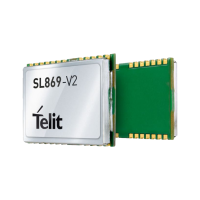If the multipath signal is attenuating the line of sight signal, then the RHCP antenna would
show a higher signal level than a linearly polarized antenna because the interfering signal
is rejected.
However, in the case where the multipath signal is replacing the line of sight signal, such
as in an urban canyon environment, then the number of satellites in view could drop
below the minimum needed to determine a 3D position. This is a case where a bad signal
may be better than no signal. The system designer needs to understand trade-offs in their
application to determine the better choice.
Active versus Passive Antenna
If the GNSS antenna is placed near the receiver and the RF trace losses are not excessive
(nominally 1 dB), then a passive antenna may be used. This would often be the lowest cost
option and most of the time the simplest to use. However, if the antenna needs to be
located away from the receiver, then an active antenna may be required to obtain the best
system performance. An active antenna includes a built-in low noise amplifier (LNA) to
overcome RF trace and cable losses. Also, many active antennas have a pre-select filter,
a post-select filter, or both.
Important specifications for an active antenna LNA are gain and noise figure.
GNSS Antenna Gain
Antenna gain is defined as the amplified signal power from the antenna compared to a
theoretical isotropic antenna (equally sensitive in all directions).
For example, a 25 mm by 25 mm square patch antenna on a reference ground plane
(usually 70 mm by 70 mm) may give an antenna gain at zenith of 5 dBic. A smaller 18 mm
by 18 mm square patch on a reference ground plane (usually 50 mm by 50 mm) may give
an antenna gain at zenith of 2 dBic.
An antenna vendor should specify a nominal antenna gain (usually at zenith (directly
overhead) and antenna pattern curves specifying gain as a function of elevation, and gain
at a fixed elevation as a function of azimuth. Pay careful attention to requirements to meet
the required design, such as ground plane size and any external matching components.
Failure to follow these requirements could result in very poor antenna performance.
It is important to note that GNSS antenna gain is not the same as external LNA gain. Most
antenna vendors will specify these numbers separately, but some combine them into a
single number. Both numbers are significant when designing the front end of a GNSS
receiver.

